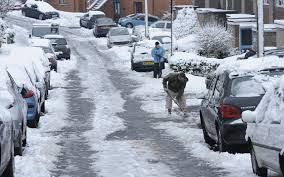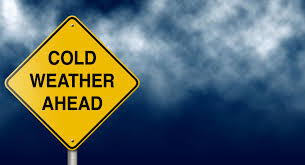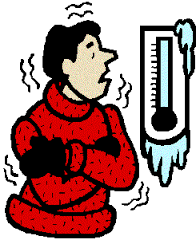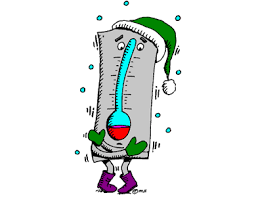Cold Environment-General:
Working in cold environments can be not only hazardous to your health but also life threatening. It is critical that the body be able to preserve core body temperature steady at + 37°C (+ 98.6°F). This thermal balance must be maintained to preserve normal body functioning as well as provide energy for activity (or work!). The body's mechanisms for generating heat (its metabolism) has to meet the challenge presented by low temperature, wind and wetness - the three major challenges of cold environments. 
lose heat to the environment?
Radiation
Radiation is the loss of heat to the environment due to the temperature gradient. In this case, it is the difference between the temperature of the air and the temperature of the body (your body's core temperature is +37°C). Another factor important in radiant heat loss is the size of the surface area exposed to cold.
Conduction
Conduction is the loss of heat through direct contact with a cooler object. Heat loss is greatest if the body is in direct contact with cold water. The body can lose 25 to 30 times more heat when in contact with cold wet objects than in dry conditions or with dry clothing. Generally, conductive heat loss accounts for only about 2% of overall loss. However, with wet clothes the loss is increased 5 times.
Convection
Convection is the loss of heat from the body to the surrounding air as the air moves across the surface of the body. The rate of heat loss from the skin by contact with cold air depends on the air speed and the temperature difference between the skin and the surrounding air. At a given air temperature, heat loss increases with wind speed. However, the effect of wind speed does not increase at speeds above 64 km/h or 50 mph since the air is not in contact with the body long enough for more body heat to be transferred to the air.
Evaporation
Evaporation is the loss of heat due to the conversion of water from a liquid to a gas. In terms of human physiology, it is:
- Perspiration/Sweating - evaporation of water to remove excess heat.
- "Insensible" Perspiration - body sweats to maintain humidity level of 70% next to skin. Particularly in a cold, dry environment, you can lose a great deal of moisture this way and not notice that you have been sweating.
- Respiration - air is heated as it enters the lungs and is exhaled with an extremely high moisture content.
It is important to recognize the strong connection between fluid levels, fluid loss, and heat loss. As body moisture is lost through the various processes, the overall circulating volume is reduced which can lead to dehydration. This decrease in fluid level makes the body more susceptible to hypothermia and other cold injuries.
We produce and retain heat within the body:
In order to survive and stay active in the cold, the constant heat loss has to be counterbalanced by the production of an equal amount of heat. Heat is both required and produced at the cellular level as a result of complex metabolic processes that convert food - a primary source of energy - into glycogen. Glycogen is a substance (biochemical compound) that is the "fuel" for biochemical processes underlying all life functions, heat production included.
Factors important for heat production include:
- Food intake.
- "Fuel" (glycogen) store.
- Fluid balance.
- Physical activity.
- Shivering - a reflex reaction, which increases the body's heat production (up to 500%) when necessary. This reaction is limited to a few hours because of depletion of muscle glycogen and the onset of fatigue.
Heat retention and tolerance to cold also depends on the body's structure, certain reflex and behavioral mechanisms that retain heat within the body as well as what you are wearing. They are:
- Size and shape of the body (surface to volume ratio).
- Layer of fat under the skin (Subcutaneous adipose tissue).
- Decreased the blood flow through the skin and outer parts of the body.
- Insulation (layering and type of clothing).
Maintain thermal balance:
Cold challenges the body in three major ways (temperature, wind and wetness). Depending on the severity of cold conditions, heat loss can occur. The body maintains its heat balance by increasing production of the heat and activating heat retention mechanisms.

In the situation where more heat is lost than the combined heat production processes and heat
retention mechanisms can generate, the core body temperature drops below +37°C. This decrease causes hypothermia which can impair normal muscular and mental functions.

Examples of jobs in which cold may be an occupational hazard:
Workers at risk of suffering due to the cold include:
- Outdoor workers including:
- Road builders, house builders and other construction workers.
- Hydro and telecommunications linemen.
- Police officers, fire fighters, emergency response workers, military personnel.
- Transport workers, bus and truck drivers.
- Fishers, hunters and trappers.
- Divers.
- Workers in refrigerated warehouses.
- Meat packaging and meat storage workers.
- Outdoor recreation workers (and enthusiasts).
Factors that determine an individual's response to the cold?
Response in Men and Women
Studies have shown that response to cold in women can differ from that of men. While the core body temperature cools more slowly in women, women are not usually able to create as much metabolic heat through exercise or shivering. In addition, the rate of cooling of the extremities (feet, hands) is faster among women. As a result, women are generally at a greater risk of cold injury.
Predisposing Conditions
Susceptibility to cold injury varies from person to person. In general, people in good physical health are less susceptible to cold injury. While anyone working in a cold environment may be at risk, the following conditions may make the risk of cold injury greater:
- Age (infants less than one year, and older adults are more susceptible).
- Diseases of the blood circulation system.

- Injuries resulting in blood loss or altered blood flow.
- Previous cold injury.
- Raynaud's Phenomenon.
- Fatigue.
- Consumption of alcohol or nicotine (smoking).
- Use of certain drugs or medication.
First aid can I do if someone has frostbite:
First aid for frostbite, as well as immersion or trench foot, includes:
- Seek medical attention.
- If possible, move the victim to a warm area.
- Gently loosen or remove constricting clothing or jewellery that may restrict circulation.
- Loosely cover the affected area with a sterile dressing. Place some gauze between fingers and toes to absorb moisture and prevent them from sticking together.
- Quickly transport the victim to an emergency care facility.
- DO NOT attempt to rewarm the affected area on site (but do try to stop the area from becoming any colder) - without the proper facilities tissue that has been warmed may refreeze and cause more damage.
- DO NOT rub area or apply dry heat.
- DO NOT allow the victim to drink alcohol or smoke.
Hypothermia:
In moderately cold environments, the body's core temperature does not usually fall more than 1°C to 2°C below the normal 37°C because of the body's ability to adapt. However, in intense cold without adequate clothing, the body is unable to compensate for the heat loss and the body's core temperature starts to fall. The sensation of cold followed by pain in exposed parts of the body is one the first signs of mild hypothermia.
As the temperature continues to drop or as the exposure time increases, the feeling of cold and pain starts to diminish because of increasing numbness (loss of sensation). If no pain can be felt, serious injury can occur without the victim's noticing it.
Next, muscular weakness and drowsiness are experienced. This condition is called hypothermia and usually occurs when body temperature falls below 33°C. Additional symptoms of hypothermia include interruption of shivering, diminished consciousness and dilated pupils. When body temperature reaches 27°C, coma (profound unconsciousness) sets in. Heart activity stops around 20°C and the brain stops functioning around 17°C.
Signs of hypothermia:
Mild Hypothermia
- 37.2-36.1ºC(99 - 97ºF)Normal, shivering may begin.
- 36.1-35ºC(97 - 95ºF)Cold sensation, goose bumps, unable to perform complex tasks with hands, shivering can be mild to severe, hands numb.
Moderate Hypothermia
- 35-33.9ºC(95 - 93ºF)Shivering, intense, muscles incoordination becomes apparent, movements slow and laboured, stumbling pace, mild confusion, may appear alert. Use sobriety test, if unable to walk a 9 meter (30 foot) straight line, the person is hypothermic.
- 33.9-32.2ºC(93 - 90ºF)Violent shivering persists, difficulty speaking, sluggish thinking, amnesia starts to appear, gross muscle movements sluggish, unable to use hands, stumbles frequently, difficulty speaking, signs of depression, withdrawn.
Severe Hypothermia
- 32.2-30ºC(90 - 86ºF)Shivering stops, exposed skin blue of puffy, muscle coordination very poor, inability to walk, confusion, incoherent/irrational behavior, but may be able to maintain posture and appearance of awareness
- 30-27.8ºC(86 - 82ºF)Muscle rigidity, semiconscious, stupor, loss of awareness of others, pulse and respiration rate decrease, possible heart fibrillation.
- 27.8-25.6ºC(82 - 78ºF)Unconscious, a heart beat and respiration erratic, a pulse may not be obvious.
- 25.6-23.9ºC(78 - 75ºF)Pulmonary edema, cardiac and respiratory failure, death. Death may occur before this temperature is reached.
First aid for hypothermia:
Hypothermia is a medical emergency. At the first sign, find medical help immediately. The survival of the victim depends on their co-workers ability to recognize the symptoms of hypothermia. The victim is generally not able to notice his or her own condition.
First aid for hypothermia includes the following steps:
- Seek medical help immediately. Hypothermia is a medical emergency.
- Ensure that wet clothing is removed.
- Place the victim between blankets (or towels, newspaper, etc.) so the body temperature can rise gradually. Body-to-body contact can help warm the victim's temperature slowly. Be sure to cover the person's head.
- Give warm, sweet (caffeine-free, nonalcoholic) drinks unless the victim is rapidly losing consciousness, unconscious, or convulsing.
- Quickly transport the victim to an emergency medical facility.
- Do not attempt to rewarm the victim on a site (e.g., do not use hot water bottles or electric blankets).
- Perform CPR (cardiopulmonary resuscitation) if the victim stops breathing. Continue to provide CPR until medical aid is available. The body slows when it is very cold and in some cases, hypothermia victims that have appeared "dead" have been successfully resuscitated.

